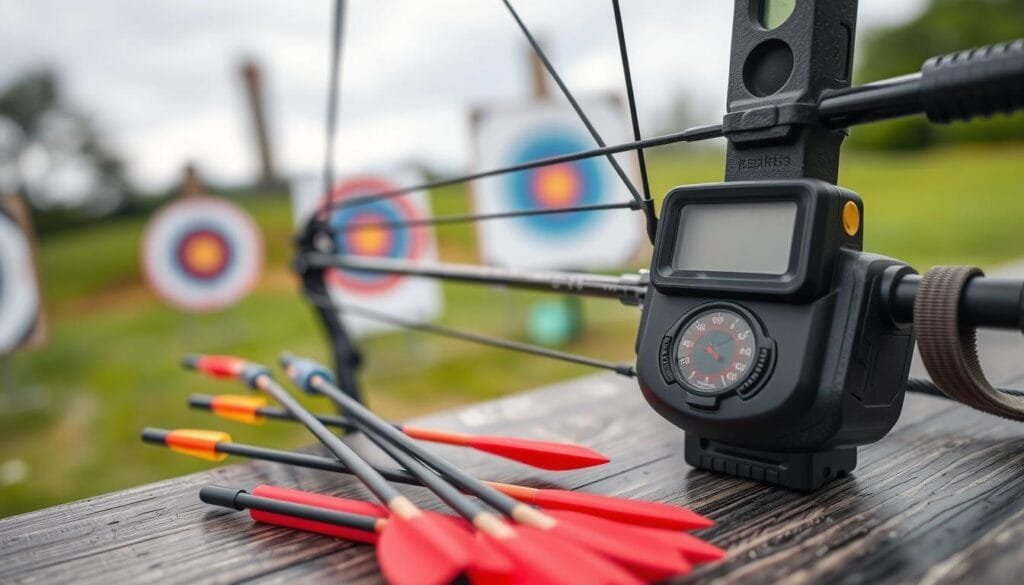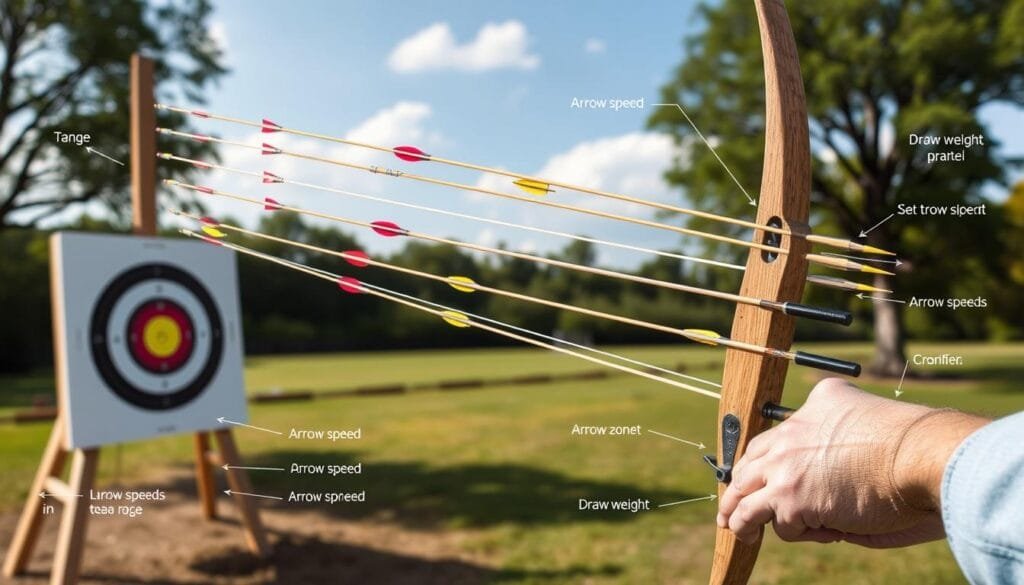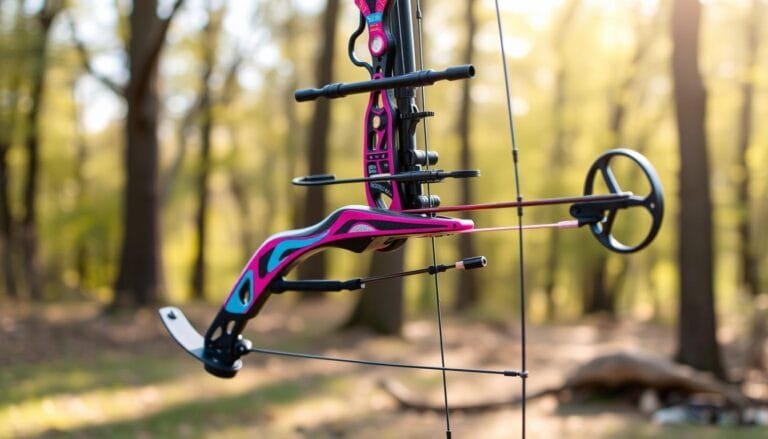Understanding FT in Archery: Arrow Speed Basics
I’ve always been intrigued by arrow speed and its role in archery. “FT” in archery means feet per second (fps). It’s key to grasping how your bow and arrow work together.
While some talk about speeds over 350 fps, most hunting setups are between 270 to 285 fps. This might seem confusing at first. But, learning about arrow speed can really improve your archery skills.
Arrow speed greatly affects your bow’s performance. It influences things like how the arrow flies, its energy, and how far it goes. Knowing about archery terminology, archery measurements, and archery units is essential. This guide is for both experienced bowhunters and casual archers. It aims to help you understand your gear and shooting better.
Table of Contents
Defining FT and Speed Measurements in Archery
In archery, knowing how fast an arrow flies is key. “FT” stands for feet per second, the speed of an arrow. It helps archers pick the best bow for them.
IBO Speed Standards and Measurements
The International Bowhunting Organization (IBO) sets a standard for arrow speed. They use an 80-pound draw weight, a long draw length, and a 400-grain arrow. This makes it easy to compare different bows.
ATA Speed Testing Methods
The Archery Trade Association (ATA) also measures arrow speed. They use a 70-pound draw weight, a 30-inch draw length, and a 350-grain arrow. This method gives a different look at bow performance.
Real-World Speed Applications
While IBO and ATA standards are useful, real-world speeds can differ. Things like draw weight, draw length, and arrow weight affect speed. Knowing this helps archers choose the right archery equipment and understand “FT” in archery.
| Measurement | Draw Weight | Draw Length | Arrow Weight |
|---|---|---|---|
| IBO Speed | 80 lbs (±2 lbs) | Maximized | 400 grains |
| ATA Speed | 70 lbs (±.2 lbs) | 30 inches | 350 grains |
“Understanding the FT meaning archery and how it is measured is key to selecting the right equipment and optimizing your bow setup.”
What Is FT in Archery: Basic Speed Terminology
Understanding archery terms explained is key for archers. FT, or feet per second, shows how fast an arrow goes when it leaves the bow.
There are important terms in archery jargon you need to know:
- Axle-to-axle length: This is the bow’s width, from one axle to the other. It’s usually between 20 to 35 inches. This length affects how stable and easy to move the bow is.
- Peep height: Where the peep sight is on the bowstring. It should match your usual shooting distance.
- D-loop: A small loop on the bowstring. It helps the archer find a consistent spot to release the string.
- String servings: Thread wrappings on the bowstring. They protect it from cuts and damage.
Knowing this archery lingo lets you talk better with other archers, coaches, and gear experts. It helps you set up your gear right and shoot better.
“Mastering the terminology is the first step to becoming a confident and knowledgeable archer.”
The Science Behind Arrow Speed and Performance
Knowing what affects arrow speed is key to better archery. Arrow speed depends on the bow’s design, draw weight, and arrow weight and construction.
Factors Affecting Arrow Velocity
The bow’s power mainly decides arrow speed. The bow’s design, draw weight, and arrow weight all matter. Heavier arrows keep their energy longer, losing less speed over distance.
Arrow spine, or stiffness, is also crucial. Static spine gives a first look, but dynamic spine considers point weight and length. These affect how the arrow bends in flight.
Understanding Kinetic Energy
Kinetic energy, based on mass and velocity, affects arrow penetration. Heavier arrows with more kinetic energy penetrate deeper. Lighter arrows, moving faster, might lose some power.
Speed vs. Accuracy Trade-offs
Faster arrows have a flatter path and more energy. But, they can be harder to aim. Finding the right balance between speed and accuracy is vital for success in archery.
By grasping the science of arrow speed and performance, you can choose the best archery equipment and archery measurements. This optimizes your setup for your archery goals.
Speed Requirements for Different Archery Disciplines
Archery has different disciplines, each with its own speed needs. Knowing these differences is key for archers aiming to do their best. Let’s look at the speed needs in various archery disciplines:
Hunting Archery
In hunting archery, rules set a minimum draw weight for certain game. For example, in Ontario, Canada, you need at least 40 pounds for whitetail hunting. Moose hunting requires 50 pounds. Faster arrows help with better penetration and game response, making them great for hunting.
Target Archery
Target archery focuses more on being consistent and accurate than speed. Archers here work on a steady shooting technique. This is more important than how fast the arrow goes.
3D Archery
In 3D archery, where targets look like real animals, speed matters. Faster arrows help with distance and aim. This gives archers an edge in competitions.
| Archery Discipline | Speed Requirements |
|---|---|
| Hunting | High arrow speed for improved penetration, trajectory, and game response time |
| Target Archery | Consistent and accurate shooting technique, with less emphasis on pure speed |
| 3D Archery | Faster arrows can enhance distance estimation and shot execution |
Speed needs in archery change with each discipline. Archers must think about their goals and the rules of their field. This helps them choose the right equipment and technique for top performance.
Essential Equipment Factors Affecting Arrow Speed
In archery, your gear matters a lot for arrow speed. The bow’s design and the arrow’s type are key. They both affect how fast your arrows fly.
Bow Type and Design Impact
The bow you pick can really change your arrow speed. Compound bows, with their complex cam systems, shoot arrows fast. Recurve and longbow bows might be slower but are great for accuracy and flexibility.
Arrow Selection Considerations
The arrow’s spine (how stiff it is) must match your bow for best results. The right weight and length of the arrow also matter for speed.
Draw Weight and Length Effects
The bow’s draw weight and length affect arrow speed. Heavier and longer bows shoot arrows faster. But, finding the right balance is key for comfort and accuracy too.
Knowing how your gear affects arrow speed helps you improve. Whether you’re competing or hunting, understanding these factors can make a big difference in your archery skills.
Measuring and Testing Arrow Speed
In archery, arrow speed is key to how well your gear works. To measure this speed, archers use special tools called chronographs.
The International Bowhunting Organization (IBO) and the Archery Trade Association (ATA) have set rules for measuring bow speeds. These rules help compare speeds fairly and get reliable data.
| Measurement | IBO Standard | ATA Standard |
|---|---|---|
| Draw Length | 30 inches | 28 inches |
| Draw Weight | 70 pounds | 60 pounds |
| Arrow Weight | 350 grains | 540 grains |
But, real-world speeds can vary from these standards. This is because of different setups and environments. To find your actual speeds, test with a chronograph.
Knowing about archery measurements helps archers understand their gear better. This knowledge lets them improve their setup for better speed and accuracy.

“Accurate arrow speed measurements are essential for understanding the true performance of your archery equipment.”
Benefits of Optimal Arrow Speed in Hunting
Faster arrows give bowhunters big advantages. They offer better penetration, flatter shots, and quicker kills. These are key for clean, ethical hunting.
Penetration Power
More arrow speed means deeper penetration. This is vital for taking down big game. Faster arrows can go through tough spots like shoulder blades, making hunting more humane.
Experts say kinetic energy, which arrow speed affects, is key. It’s the square of the arrow’s speed.
Trajectory Advantages
Higher speeds mean arrows fly straighter. At 30 yards, a 280 fps arrow drops only 9.5 inches. This makes aiming easier and reduces misses.
Game Response Time
Faster arrows mean animals react slower. This helps when hunting quick animals like deer and antelope. Every second matters.
Finding the right balance between speed and weight is important. Lighter arrows are faster but heavier ones penetrate better. It’s all about what works best for you and your hunting style.
| Arrow Speed (fps) | Deer Drop at 30 Yards (inches) |
|---|---|
| 230 | 16.75 |
| 280 | 9.5 |
Faster arrows give bowhunters an edge. They offer better penetration, straighter shots, and quicker kills. By balancing speed and weight, hunters can improve their chances of success.
Common Speed-Related Archery Terms
As an archer, knowing key speed terms is key to better performance. Let’s explore common archery lingo and jargon about arrow speed and archery dynamics.
IBO speed is the arrow’s speed in feet per second (fps) by the International Bowhunting Organization (IBO) standards. ATA speed is the speed protocol by the Archery Trade Association (ATA).
Actual speed is the real arrow speed during shooting. It can vary from IBO or ATA speeds due to bow tuning, arrow choice, and environment.
| Archery Term | Definition |
|---|---|
| Brace Height | The distance between the string and the bow’s grip, affecting arrow speed and accuracy. |
| Let-off | The percentage of draw weight relieved at full draw, impacting the archer’s effort. |
| Cam Design | The bow’s cam shape, which affects arrow velocity and trajectory. |
Knowing these terms helps you understand how bow and equipment choices impact your arrow speed and archery performance.
“The most important factor in archery is not the equipment, but the skill of the archer.”
As you improve your archery skills, remember these speed terms. They help you make better gear choices and enhance your shooting experience.
Speed Myths and Misconceptions in Archery
In archery, many believe slower arrows are more accurate. But, modern technology has changed this. Today, archers can hit their mark fast and accurately.
It’s not just about how fast an arrow goes. A good setup balances speed, energy, and precision. This balance is key for both competition and hunting.
Some think quiet bows are better than fast ones. But, speed and trajectory are also important. The best choice depends on the archer’s needs and the hunt.
- Slower arrows are not necessarily more accurate
- Maximum speed should not be the sole focus
- Quiet bows are not always better than faster ones
Knowing the truth about archery can help archers make better choices. Understanding archery terminology and ft meaning archery unlocks the potential of modern gear.

“The key is to find the right balance between speed, kinetic energy, and precision for your specific archery discipline and hunting scenarios.”
Optimizing Your Setup for Ideal Speed
To get the best arrow speed in archery, you need to fine-tune your gear. This means picking the right arrow parts, adjusting your bow, and tweaking your equipment’s performance.
Tuning for Performance
Choosing the right arrows is key for top speed. Look at shaft straightness, spine, and diameter to match your bow. Shaft straightness should be between .001 and .006 inches for better accuracy.
Arrow spine, like 500 or 400, affects how the arrow flies. The right spine is crucial to avoid accuracy issues from arrow flex.
Try adding stabilizers and counterweights to balance your bow. This helps with accuracy by offsetting the weight of your quiver.
Equipment Matching Guidelines
When picking your gear, aim for speed and stability balance. A good ratio is 6 to 6.5 grains per pound of draw force. This ensures your arrows fly fast and straight.
Adjusting your bow’s cam timing and arrow rest also boosts performance. Fine-tuning with paper tuning and long-range tests can make your shots more consistent and fast.
By optimizing your archery equipment and fine-tuning, you can hit the perfect speed and accuracy. Your arrows will perform well on the range or in the field.
Safety Considerations with High-Speed Arrows
Archery’s arrow speed is key and must be handled with care. With arrows now reaching over 370 feet per second, safety is paramount. It’s crucial to pick the right arrows and keep your gear in top shape to avoid damage or danger.
Choosing the right arrow spine is essential. A spine that’s too weak can cause serious issues, even harm. Always check the manufacturer’s advice or talk to an archery expert to find the best spine for your bow.
High-speed arrows can penetrate deeply, so you need to be extra cautious. These arrows can go through targets, so use backstops and targets made for stopping them. Always think about what’s behind your target to avoid accidents or damage.
- Ensure proper arrow spine selection to prevent bow damage or arrow failure
- Be aware of increased penetration power and potential for pass-through shots
- Always use appropriate targets capable of stopping fast arrows
- Be mindful of what lies beyond your target
By focusing on safety and following best practices, you can enjoy the thrill of high-speed archery. Remember, using archery equipment and archery terminology wisely is key to a safe and fun archery experience.
“Archery is not just about speed; it’s about precision, control, and above all, safety.”
Conclusion
Knowing about feet-per-second (FT) in archery is key to better performance and choosing the right gear. Arrow speed helps with better aim, deeper penetration, and quicker game reaction. But, it’s important to balance speed with accuracy and safety.
Modern archery tools let you mix speed with other good traits for different types of archery. This includes what is ft in archery, archery terminology, and archery measurements.
Arrow speed science and what affects it, like bow type and arrow choice, are vital for archers. Learning to measure and test arrow speed helps you improve your skills. It also keeps you safe and responsible.
Getting FT in archery right isn’t just about being fast. It’s about finding the right mix for you. By using the tips from this article, you can make your archery better. This is true for competitive shooters, bowhunters, or archery fans.
FAQ
What does FT stand for in archery?
How fast do most hunting arrows travel?
What factors affect arrow speed?
What is IBO and ATA speed?
What other important archery terms should I know?
How does arrow velocity impact performance?
What are the speed requirements for different archery disciplines?
How do different bow types affect arrow speed?
How is arrow speed typically measured?
What are the benefits of faster arrows for hunting?
What are some common misconceptions about arrow speed?
How do I optimize my setup for ideal arrow speed?
What safety precautions should I take with high-speed arrows?
Source Links
- How Much Kinetic Energy For Bowhunting?
- The value of understanding ballistics in archery.
- Introduction to Archery: Terminology, Definitions, and Specifications – Landscapes & Letters
- Bow Performance — A&H Archery
- Making Sense of Bow Specs
- What is Feet per Second in Archery?
- Glossary of Archery Terms | home
- The Science of Archery
- Arrows: Physical Properties
- Part IV: The Physics of Arrow Penetration, By Dr. Ed Ashby – Journal of Mountain Hunting
- Archery Bow Types & Types of Archery | Archery GB
- Archery: From rules to Olympic records, all you need to know
- What is Feet per Second in Archery?
- HOW IMPORTANT IS ARROW SPEED? CONSIDERATIONS FOR KILLER ARROWS
- KSL International Archery
- Arrow Speed Calculator
- Reliability and Validity Testing of an Archery Chronometer
- Benefits of Arrow Speed
- Heavy vs. Light Arrows: Which Are Better for Deer Hunting? | National Deer Association
- Arrow Weight vs Arrow Speed — Is A Heavy, Light, or Balanced Arrow the Best for Bowhunting?
- What Arrow Speeds & Arrow Weights do Olympic Archers…
- Bowhunting and Archery Terms
- Medieval versus Modern Archery – Dan Koboldt
- Myths and Truths in Archery Hunting
- The be-all and end-all definitive guide for how to build the perfect arrow // GOHUNT. The Hunting Company
- 10 Ways to Maximize Your Bow’s Performance
- What You Need to Know When Choosing an Arrow – Landscapes & Letters
- Microsoft Word – 01 Archery Book pgs 1-36
- 11 Steps to Archery Success
- May 2021 – Understanding Archery
- Archery 101: Olympic competition format and scoring







